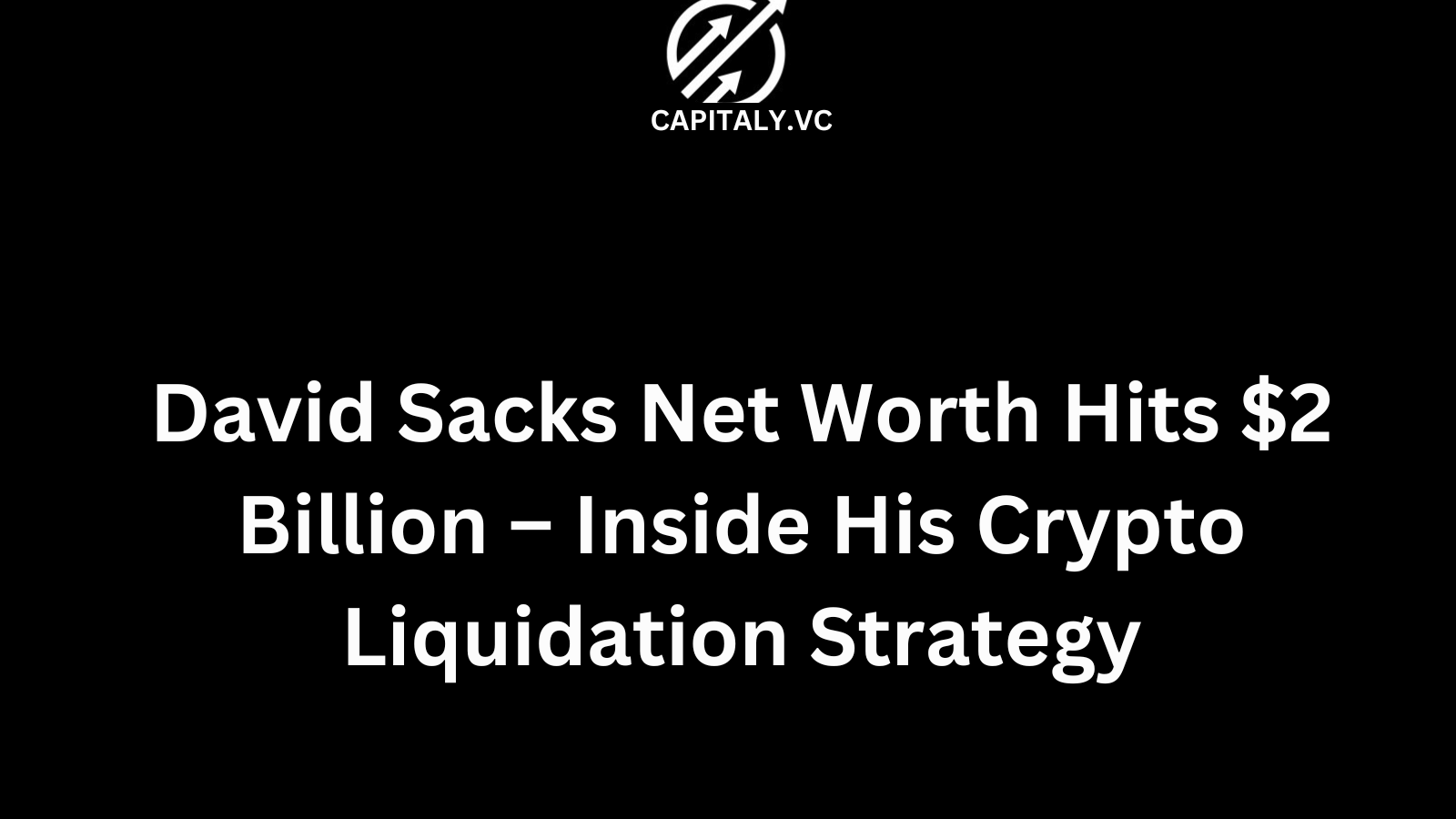David Sacks just joined the billionaire club — again.
With recent disclosures showing his net worth surpassing $2 billion, much of that surge stems not from SaaS exits or SPAC plays…
…but from a highly strategic crypto liquidation strategy that other founders and investors would be smart to study.
In this article, we’ll unpack:
- How Sacks made (and preserved) his crypto fortune
- Why his liquidation strategy flew under the radar
- What this means for startup founders in AI and Web3
- And what lessons you can steal right now to manage your own liquidity roadmap

1. Wait — David Sacks Is a Billionaire?
Yes, again.
While Sacks was always wealthy from early PayPal, Yammer, and venture wins (Uber, Palantir, SpaceX, etc.), recent filings and private reports suggest:
His net worth has now crossed $2B — driven in part by quietly timed crypto exits.
That includes Ethereum, Solana, and stakes in crypto infrastructure deals most never heard of until they 10x’d.
2. He Wasn’t Flashy — He Was Strategic
Unlike many crypto bros who posted every buy/sell, Sacks:
- Rarely tweeted about personal trades
- Avoided memecoins and retail hype
- Focused on infrastructure, custody, and layer-1 bets
- Participated in SAFTs and early rounds via Craft Ventures
- Set up entity-based liquidation pathways (more on that below)
This wasn't gambling.
It was precision.
3. Inside the Liquidation Strategy: Quiet, Fast, Legal
Sacks reportedly structured his liquidation with 3 key principles:
1. Entity Separation
He held most crypto assets in separate Craft-affiliated entities — giving him cap table flexibility and legal insulation.
2. Layered Tranches
Exits were triggered via automated tranche rules — not gut calls. This allowed him to sell ~20% at 3x, 20% at 5x, and keep the rest for asymmetric upside.
3. Low-Visibility OTC Transactions
Instead of market dumps, he coordinated large OTC (over-the-counter) trades to institutional buyers — preserving price and reputation.
4. Why He Sold When Others Held
Sacks didn’t fall in love with the tech.
He sold:
- When token unlocks signaled peak liquidity
- When VC rounds in Web3 started cooling
- When macro signals (rate hikes, regulatory shifts) began tightening
He wasn’t emotional.
He was positional.
5. Sacks’ Crypto Portfolio Highlights
While much remains private, here’s what’s known or reported:
- Early ETH and SOL holdings via private rounds
- StarkWare and BitGo equity stakes
- Craft Ventures positions in Chainalysis, CoinTracker, Notional
- Exposure to tokenized RWAs and on-chain identity plays
Unlike many, he bet on pipes, not coins.
6. What Founders Can Learn from This
If you're holding tokens, SAFEs, or future liquidity:
- Design your liquidation rules before the hype hits
- Use entities to isolate risk and optimize tax
- Consider OTC channels for large exits
- Automate partial exits with tranche logic
- Don’t tie your self-worth to your cap table
Need help planning this?
Check our guide: Startup Founder Liquidity Planning 101
7. Why This Matters in 2025
In the current macro cycle:
- VC dry powder is tightening
- AI/crypto founders are raising SAFEs with token warrants
- Secondary markets are heating up again
David Sacks just set the bar for how to exit strategically without burning bridges.
8. Not Just Crypto – He’s Doing the Same with AI
Sacks is reportedly applying the same playbook to AI:
- Early-stage AI infra investments
- Pre-IPO secondary purchases
- Tranche-based exit rules
- Regulatory risk management via D.C. relationships
Want to know which AI companies Sacks is watching?
See: David Sacks – Craft Ventures Investment Thesis and Notable Investments
9. The “Sacks Doctrine”: Liquidity Is a Strategy, Not a Panic
Too many founders:
- Wait too long to sell
- Feel guilty about cashing out
- Tie identity to valuations
- Miss windows of asymmetry
Sacks teaches the opposite:
“The goal is not to die holding bags. It’s to live to fund the next asymmetric bet.”
10. How Founders Should Prepare
If you're in AI, crypto, or defense — and holding illiquid equity or tokens:
✅ Build a personal liquidity strategy
✅ Separate asset classes by entity
✅ Model upside/downside scenarios now
✅ Watch what smart LPs and GPs are doing — not tweeting
Sacks isn’t flashy.
He’s focused.
Be like Sacks.
FAQs
1. How did David Sacks make $2 billion?
From a mix of early startup equity (Yammer, PayPal), venture wins (Uber, OpenAI, Palantir), and strategic crypto liquidation at the top.
2. When did he start selling crypto?
Around 2021–2022 peaks, reportedly using OTC sales and tranche logic.
3. What makes his strategy unique?
Entity separation, non-emotional exit rules, OTC privacy, and infra-first bets.
4. Does he still hold crypto?
Yes — but mostly infrastructure and RWA exposure, not speculative tokens.
5. Should founders copy his strategy?
Not directly, but the principles (structure, automation, tax efficiency) are worth emulating.
6. What about taxes?
Sacks likely optimized through entity-based planning. Founders should consult advisors early.
7. What’s the biggest mistake founders make with liquidity?
Waiting too long. Or selling everything at once.
8. Does this apply to AI startups?
Yes — especially those issuing tokens, NFTs, or equity with hybrid value.
9. Can I still exit tokens in this market?
Yes — OTC desks, DAOs, and secondaries are active. But be strategic.
10. Where can I learn more?
Start here: Fundraising Is a Process, Not a Project
Conclusion
David Sacks hitting $2B net worth isn’t just a headline — it’s a masterclass in quiet, strategic, founder-style wealth management.
He didn’t brag.
He didn’t panic.
He structured, liquidated, and moved on to fund the next wave.
Subscribe to Capitaly.vc Substack (https://capitaly.substack.com/) to raise capital at the speed of AI.


.png)